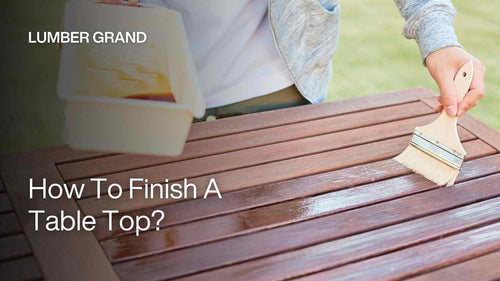How to polish epoxy table top the right way? It’s a simple yet essential process that transforms your epoxy project from dull to dazzling. Polishing epoxy projects after completion represents a fundamental process that produces an elegant glossy finish. Our quick guide to attaining flawless polishing on epoxy resin finishes exists below.
Why Should You Polish Your Epoxy Table Top?
Polishing an epoxy resin table top allows users to eliminate surface flaws, which include marks and patches of dullness together with uneven areas. Knowing how to polish epoxy table top properly not only enhances its appearance but also plays a key role in protecting the surface, making it resistant to wear and tear, and removing porous surfaces that can trap moisture and bacteria, helping it easier to clean. Learning how to epoxy a table top requires finishing it with polishing in order to reveal its maximum beauty and durability.
Simple Steps to Polish Epoxy Table Top
Learning how to polish epoxy table top is simpler than you thought. You can revive the original shine or improve the finish of your epoxy table top through standard tools alongside basic procedures. Continue reading to discover our step-by-step instructions!
Step 1: Gather the Right Tools
Gather everything before starting to save time and ensure a smooth workflow. To achieve a smooth, glossy epoxy finish, you’ll need a few essential tools:
-
Sandpaper (120-2000 grit): Sandpaper is your first step in removing imperfections. Start with lower grit (coarse) and gradually move to higher grit (fine) for a smooth finish.
-
Buffing wheel or orbital polisher: While hand polishing is an option, a buffing wheel is far more efficient and gives more consistent results, especially for large surfaces.
-
Polishing compound: High-quality epoxy-formulated polishing compounds suitable for resin such as Meguiar’s M105 or Novus 2 can be effectively used for this purpose. These designed products aim to eliminate small scratches and achieve a brilliant and perfect gloss finish.
-
Lint-free, scratch-free microfiber cloths.
-
Water spray bottle or clean water: Use water during wet sanding to reduce dust and avoid overheating the surface.

Prepare sandpaper & tools for polishing epoxy table top
Photo: ©VITALII BORKOVSKYI on Canva.com
Step 2: Clean the Surface Before Polishing
Before start how to polish epoxy table top, you need to make sure that your epoxy is fully cured, which requires waiting times between 48 hours and 7 days. Marking the surface and possibly destroying it will occur if you attempt sanding and polishing before the epoxy reaches full hardness.
A soft microfiber cloth with dampness should be used for smooth surface cleaning. Complete the process by wiping away all remaining dust residues and oils together with debris. At this stage, only utilize either soap and water or glass cleaner since rough cleaning chemicals should be avoided. The surface will become ready for sanding after it fully dries.

Clean the epoxy table top before polishing
Photo: ©pixelshot on Canva.com
Step 3: Sanding Process
Sanding eliminates material from surfaces to create an even base that is ready for polish compound. Use a 120 grit sandpaper as the first step for rough initial sanding, then gradually move to medium surfaces like 180 and 240, and finish with fine grit numbers 400 and 1200. Follow right to left sanding with a separate sanding pass going straight across the first direction.
The procedure produces an even surface that extends throughout the table. Maintain consistent, even pressure with your sanding motions while working on this sanding stage. Apply this process to a sandpaper grit sequence of at least 5 rounds for each step.

Sanding process
Photo: GlassCast Resin on instructables.com
Step 4: Gather the Right Tools for Polishing and Buffing Epoxy
Double-check your materials before jumping into how to polish epoxy table top:
-
Make sure your buffing pad is clean.
-
Choose a polishing compound designed for epoxy or plastic. Avoid automotive compounds unless they are labeled safe for plastics and resins.
-
Secure your table on a stable surface and clear your workspace to avoid dust settling on your newly sanded table top.

Gather the right tools for polishing
Photo: ©Alexander's Images on Canva.com
Step 5: Polishing Process
If your surface is a mix of wood and resin, we recommend sealing your wood before proceeding with the polishing process to avoid stains from the polish compound. Apply a small amount of polish compound to the surface. Use a clean buffing wheel on a low setting to gently work the compound into the epoxy, covering all areas evenly.
Remember to avoid overheating the resin. Add more polish compound and repeat the process as needed. Continue polishing until the compound completely diminishes and the surface is free from dull spots.

Keep polishing until there are no more dull spots on your epoxy table top
Photo: Von Madel Delfin on resiners.com
Read more: How to make a mold for epoxy resin table?
Step 6: Remove Residue After Polishing
A clean, dry microfiber cloth will let you remove leftover. This is the answer for how to polish epoxy table top when you achieve the desired shine. Use a circular motion and gentle strokes to buff the area until no marks or whitened spots appear. The table top surface becomes extremely transparent and reflective after this treatment.
Some people select furniture wax or oil as an additional finishing step, but the application is optional for a high-gloss sheen.

The mirror finish you can achieve after removing any residue
Photo: Von Madel Delfin on resiners.com
Common Mistakes & How to Avoid Them
-
Resin surface is not completely cured: Unhardened epoxy surfaces become permanently damaged when polished because it leaves behind visible marks or smudging. We strongly recommend to make sure it has completely cured first.
-
Rushing the sanding process: Your projects will face a major setback if you rush your sanding work since it leads to unsuitable finishing of surfaces and structurally damaging projects. Maintain patient care while keeping tension even.
-
Not using the polish compound correctly: Each time you add more polish compound, you need to work it into the epoxy until the layer is so thin it looks like it has completely disappeared. Otherwise, it just won't be able to achieve the same shine.
-
Using oil/the wrong polish compound for polishing: Oils can provide a temporary shine but won’t be able to provide the same protection and durability that polishing compounds specifically made for epoxy resin can.
How to Maintain the Shine After Polishing?
To maintain the shine on epoxy resin after polishing, you must know how to clean epoxy table top with a nonscratch cloth and gentle chemicals. A high-quality compound should be used during polishing to extend the durability of the shine, and you should prevent resin from directly exposing itself to sunlight.
Our email address contact@lumbergrand.com is open for any questions or inquiries about additional epoxy products.
Now that you know how to polish epoxy table top, you can apply our method and create a durable, high-gloss piece. The correct combination of proper tools and methods alongside patience enables you to make new-looking epoxy surfaces that show their beauty and longevity.

















































